Victoria University Business Law Assignment: John vs. Span and Spic
VerifiedAdded on 2022/08/26
|12
|2476
|18
Report
AI Summary
This business law assignment analyzes a case involving John, a business graduate, and the dry cleaner Span and Spic. The assignment is divided into two parts. Part A focuses on the formation of a contract between John and Span and Spic, examining the elements of a valid contract including offer, acceptance, intention, consideration, and capacity. The analysis applies these legal principles to the scenario, concluding that a contract was formed. Part B examines whether Span and Spic can rely on an exclusion clause, first under general contract law, and then under Australian Consumer Law. It explores the validity of the exclusion clause and the implications of consumer guarantees regarding services. The assignment concludes that the exclusion clause is invalid and that Span and Spic may have breached consumer guarantees.
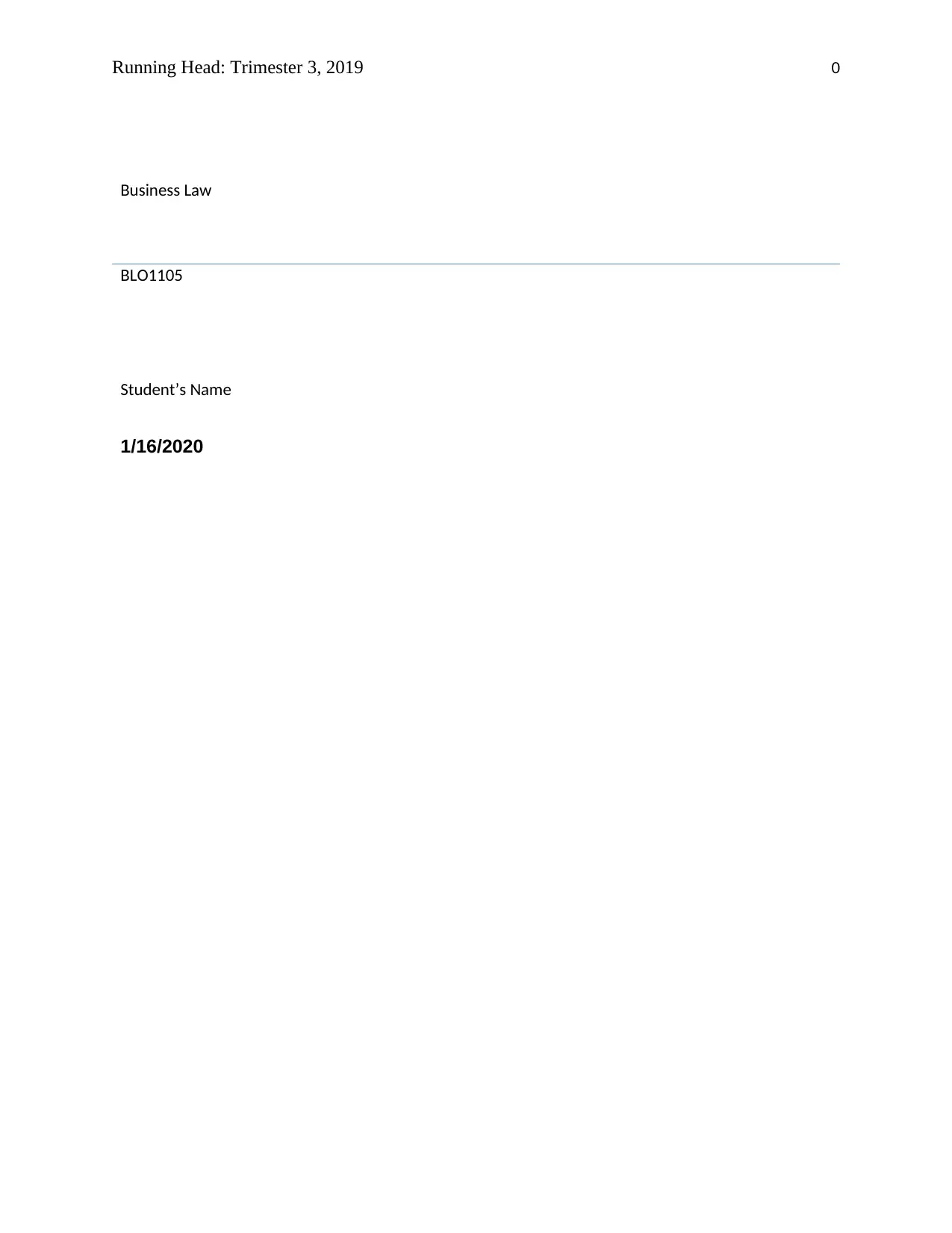
Running Head: Trimester 3, 2019 0
Business Law
BLO1105
Student’s Name
1/16/2020
Business Law
BLO1105
Student’s Name
1/16/2020
Paraphrase This Document
Need a fresh take? Get an instant paraphrase of this document with our AI Paraphraser
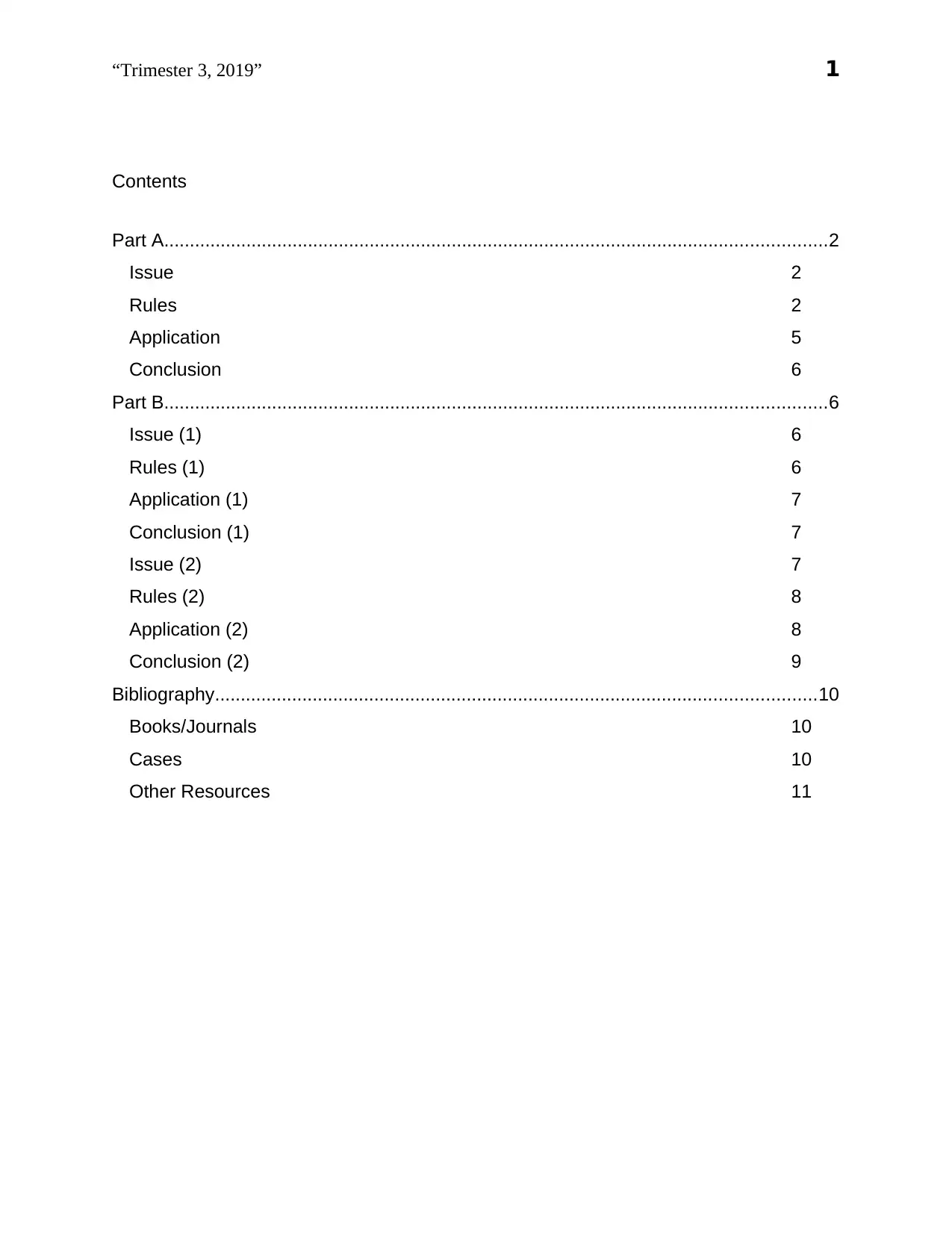
“Trimester 3, 2019” 1
Contents
Part A.................................................................................................................................2
Issue 2
Rules 2
Application 5
Conclusion 6
Part B.................................................................................................................................6
Issue (1) 6
Rules (1) 6
Application (1) 7
Conclusion (1) 7
Issue (2) 7
Rules (2) 8
Application (2) 8
Conclusion (2) 9
Bibliography.....................................................................................................................10
Books/Journals 10
Cases 10
Other Resources 11
Contents
Part A.................................................................................................................................2
Issue 2
Rules 2
Application 5
Conclusion 6
Part B.................................................................................................................................6
Issue (1) 6
Rules (1) 6
Application (1) 7
Conclusion (1) 7
Issue (2) 7
Rules (2) 8
Application (2) 8
Conclusion (2) 9
Bibliography.....................................................................................................................10
Books/Journals 10
Cases 10
Other Resources 11
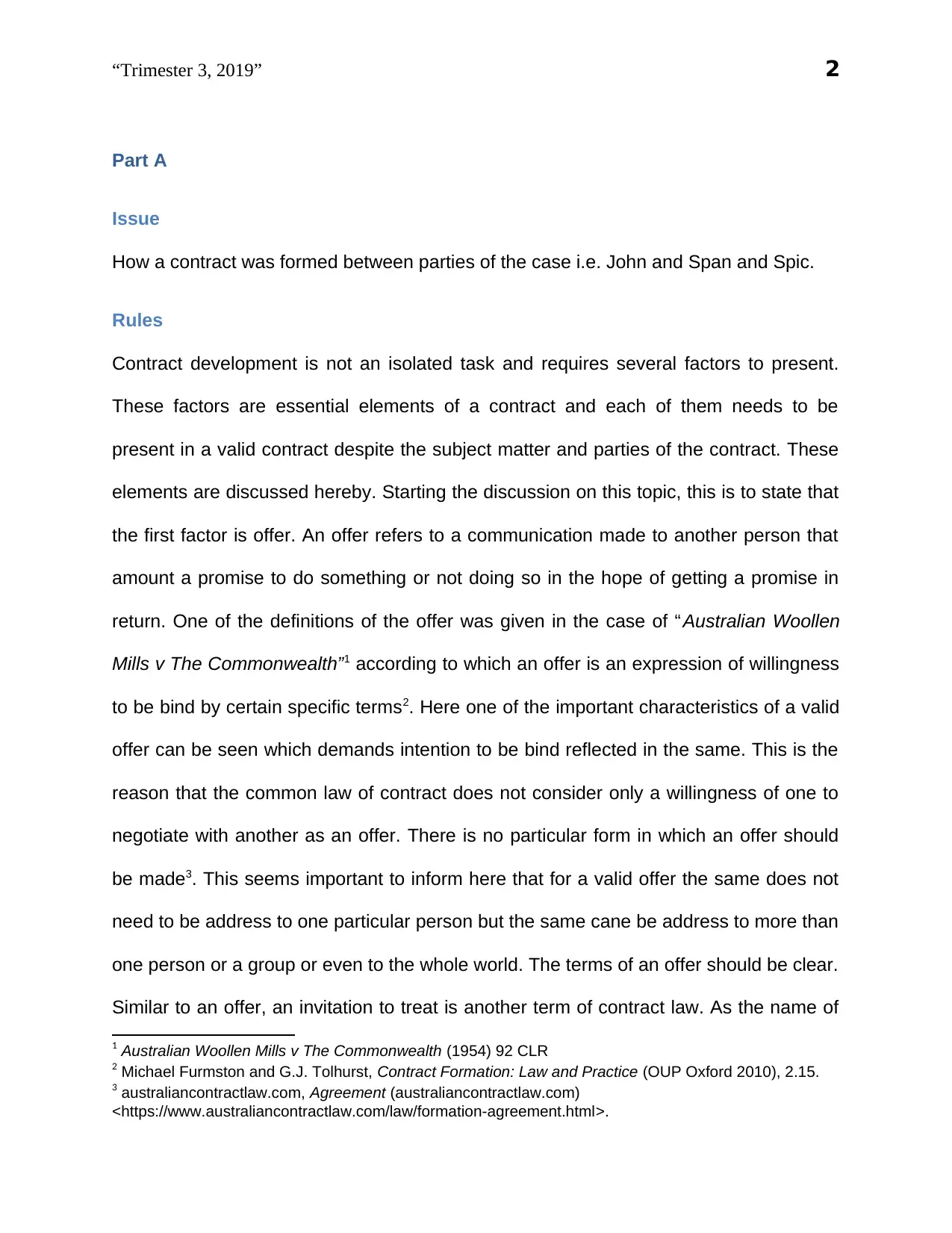
“Trimester 3, 2019” 2
Part A
Issue
How a contract was formed between parties of the case i.e. John and Span and Spic.
Rules
Contract development is not an isolated task and requires several factors to present.
These factors are essential elements of a contract and each of them needs to be
present in a valid contract despite the subject matter and parties of the contract. These
elements are discussed hereby. Starting the discussion on this topic, this is to state that
the first factor is offer. An offer refers to a communication made to another person that
amount a promise to do something or not doing so in the hope of getting a promise in
return. One of the definitions of the offer was given in the case of “ Australian Woollen
Mills v The Commonwealth”1 according to which an offer is an expression of willingness
to be bind by certain specific terms2. Here one of the important characteristics of a valid
offer can be seen which demands intention to be bind reflected in the same. This is the
reason that the common law of contract does not consider only a willingness of one to
negotiate with another as an offer. There is no particular form in which an offer should
be made3. This seems important to inform here that for a valid offer the same does not
need to be address to one particular person but the same cane be address to more than
one person or a group or even to the whole world. The terms of an offer should be clear.
Similar to an offer, an invitation to treat is another term of contract law. As the name of
1 Australian Woollen Mills v The Commonwealth (1954) 92 CLR
2 Michael Furmston and G.J. Tolhurst, Contract Formation: Law and Practice (OUP Oxford 2010), 2.15.
3 australiancontractlaw.com, Agreement (australiancontractlaw.com)
<https://www.australiancontractlaw.com/law/formation-agreement.html>.
Part A
Issue
How a contract was formed between parties of the case i.e. John and Span and Spic.
Rules
Contract development is not an isolated task and requires several factors to present.
These factors are essential elements of a contract and each of them needs to be
present in a valid contract despite the subject matter and parties of the contract. These
elements are discussed hereby. Starting the discussion on this topic, this is to state that
the first factor is offer. An offer refers to a communication made to another person that
amount a promise to do something or not doing so in the hope of getting a promise in
return. One of the definitions of the offer was given in the case of “ Australian Woollen
Mills v The Commonwealth”1 according to which an offer is an expression of willingness
to be bind by certain specific terms2. Here one of the important characteristics of a valid
offer can be seen which demands intention to be bind reflected in the same. This is the
reason that the common law of contract does not consider only a willingness of one to
negotiate with another as an offer. There is no particular form in which an offer should
be made3. This seems important to inform here that for a valid offer the same does not
need to be address to one particular person but the same cane be address to more than
one person or a group or even to the whole world. The terms of an offer should be clear.
Similar to an offer, an invitation to treat is another term of contract law. As the name of
1 Australian Woollen Mills v The Commonwealth (1954) 92 CLR
2 Michael Furmston and G.J. Tolhurst, Contract Formation: Law and Practice (OUP Oxford 2010), 2.15.
3 australiancontractlaw.com, Agreement (australiancontractlaw.com)
<https://www.australiancontractlaw.com/law/formation-agreement.html>.
⊘ This is a preview!⊘
Do you want full access?
Subscribe today to unlock all pages.

Trusted by 1+ million students worldwide
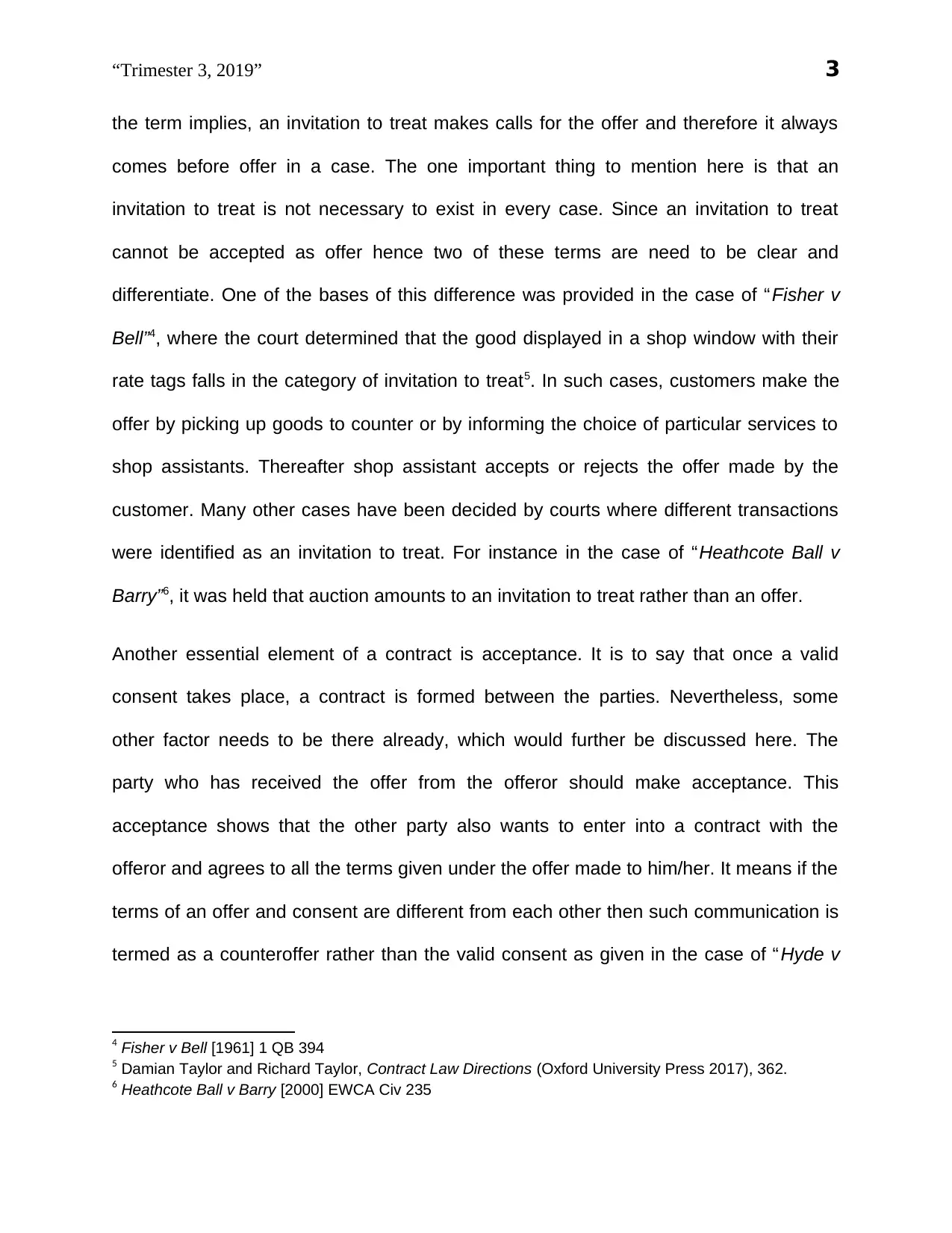
“Trimester 3, 2019” 3
the term implies, an invitation to treat makes calls for the offer and therefore it always
comes before offer in a case. The one important thing to mention here is that an
invitation to treat is not necessary to exist in every case. Since an invitation to treat
cannot be accepted as offer hence two of these terms are need to be clear and
differentiate. One of the bases of this difference was provided in the case of “ Fisher v
Bell”4, where the court determined that the good displayed in a shop window with their
rate tags falls in the category of invitation to treat5. In such cases, customers make the
offer by picking up goods to counter or by informing the choice of particular services to
shop assistants. Thereafter shop assistant accepts or rejects the offer made by the
customer. Many other cases have been decided by courts where different transactions
were identified as an invitation to treat. For instance in the case of “Heathcote Ball v
Barry”6, it was held that auction amounts to an invitation to treat rather than an offer.
Another essential element of a contract is acceptance. It is to say that once a valid
consent takes place, a contract is formed between the parties. Nevertheless, some
other factor needs to be there already, which would further be discussed here. The
party who has received the offer from the offeror should make acceptance. This
acceptance shows that the other party also wants to enter into a contract with the
offeror and agrees to all the terms given under the offer made to him/her. It means if the
terms of an offer and consent are different from each other then such communication is
termed as a counteroffer rather than the valid consent as given in the case of “ Hyde v
4 Fisher v Bell [1961] 1 QB 394
5 Damian Taylor and Richard Taylor, Contract Law Directions (Oxford University Press 2017), 362.
6 Heathcote Ball v Barry [2000] EWCA Civ 235
the term implies, an invitation to treat makes calls for the offer and therefore it always
comes before offer in a case. The one important thing to mention here is that an
invitation to treat is not necessary to exist in every case. Since an invitation to treat
cannot be accepted as offer hence two of these terms are need to be clear and
differentiate. One of the bases of this difference was provided in the case of “ Fisher v
Bell”4, where the court determined that the good displayed in a shop window with their
rate tags falls in the category of invitation to treat5. In such cases, customers make the
offer by picking up goods to counter or by informing the choice of particular services to
shop assistants. Thereafter shop assistant accepts or rejects the offer made by the
customer. Many other cases have been decided by courts where different transactions
were identified as an invitation to treat. For instance in the case of “Heathcote Ball v
Barry”6, it was held that auction amounts to an invitation to treat rather than an offer.
Another essential element of a contract is acceptance. It is to say that once a valid
consent takes place, a contract is formed between the parties. Nevertheless, some
other factor needs to be there already, which would further be discussed here. The
party who has received the offer from the offeror should make acceptance. This
acceptance shows that the other party also wants to enter into a contract with the
offeror and agrees to all the terms given under the offer made to him/her. It means if the
terms of an offer and consent are different from each other then such communication is
termed as a counteroffer rather than the valid consent as given in the case of “ Hyde v
4 Fisher v Bell [1961] 1 QB 394
5 Damian Taylor and Richard Taylor, Contract Law Directions (Oxford University Press 2017), 362.
6 Heathcote Ball v Barry [2000] EWCA Civ 235
Paraphrase This Document
Need a fresh take? Get an instant paraphrase of this document with our AI Paraphraser
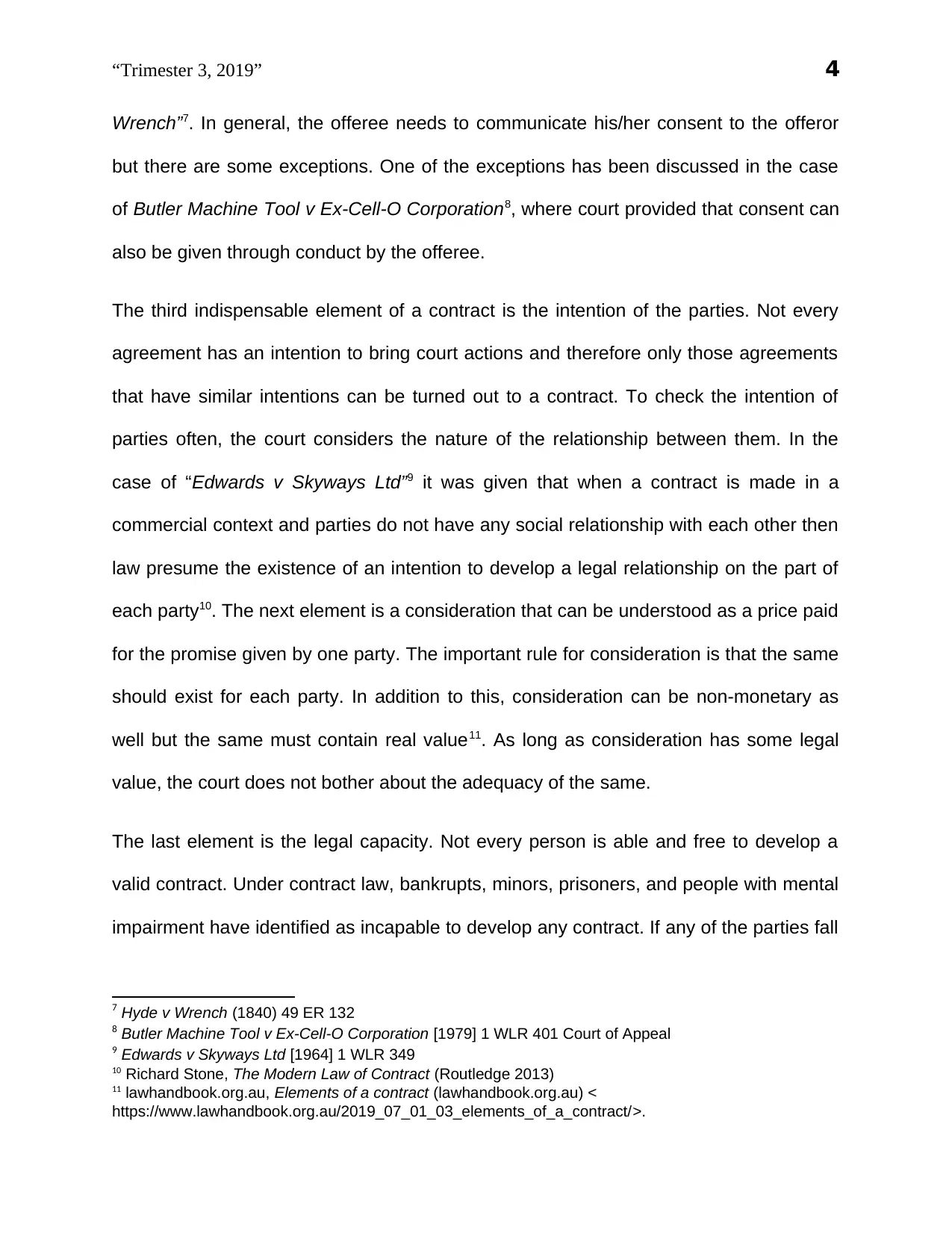
“Trimester 3, 2019” 4
Wrench”7. In general, the offeree needs to communicate his/her consent to the offeror
but there are some exceptions. One of the exceptions has been discussed in the case
of Butler Machine Tool v Ex-Cell-O Corporation8, where court provided that consent can
also be given through conduct by the offeree.
The third indispensable element of a contract is the intention of the parties. Not every
agreement has an intention to bring court actions and therefore only those agreements
that have similar intentions can be turned out to a contract. To check the intention of
parties often, the court considers the nature of the relationship between them. In the
case of “Edwards v Skyways Ltd”9 it was given that when a contract is made in a
commercial context and parties do not have any social relationship with each other then
law presume the existence of an intention to develop a legal relationship on the part of
each party10. The next element is a consideration that can be understood as a price paid
for the promise given by one party. The important rule for consideration is that the same
should exist for each party. In addition to this, consideration can be non-monetary as
well but the same must contain real value11. As long as consideration has some legal
value, the court does not bother about the adequacy of the same.
The last element is the legal capacity. Not every person is able and free to develop a
valid contract. Under contract law, bankrupts, minors, prisoners, and people with mental
impairment have identified as incapable to develop any contract. If any of the parties fall
7 Hyde v Wrench (1840) 49 ER 132
8 Butler Machine Tool v Ex-Cell-O Corporation [1979] 1 WLR 401 Court of Appeal
9 Edwards v Skyways Ltd [1964] 1 WLR 349
10 Richard Stone, The Modern Law of Contract (Routledge 2013)
11 lawhandbook.org.au, Elements of a contract (lawhandbook.org.au) <
https://www.lawhandbook.org.au/2019_07_01_03_elements_of_a_contract/>.
Wrench”7. In general, the offeree needs to communicate his/her consent to the offeror
but there are some exceptions. One of the exceptions has been discussed in the case
of Butler Machine Tool v Ex-Cell-O Corporation8, where court provided that consent can
also be given through conduct by the offeree.
The third indispensable element of a contract is the intention of the parties. Not every
agreement has an intention to bring court actions and therefore only those agreements
that have similar intentions can be turned out to a contract. To check the intention of
parties often, the court considers the nature of the relationship between them. In the
case of “Edwards v Skyways Ltd”9 it was given that when a contract is made in a
commercial context and parties do not have any social relationship with each other then
law presume the existence of an intention to develop a legal relationship on the part of
each party10. The next element is a consideration that can be understood as a price paid
for the promise given by one party. The important rule for consideration is that the same
should exist for each party. In addition to this, consideration can be non-monetary as
well but the same must contain real value11. As long as consideration has some legal
value, the court does not bother about the adequacy of the same.
The last element is the legal capacity. Not every person is able and free to develop a
valid contract. Under contract law, bankrupts, minors, prisoners, and people with mental
impairment have identified as incapable to develop any contract. If any of the parties fall
7 Hyde v Wrench (1840) 49 ER 132
8 Butler Machine Tool v Ex-Cell-O Corporation [1979] 1 WLR 401 Court of Appeal
9 Edwards v Skyways Ltd [1964] 1 WLR 349
10 Richard Stone, The Modern Law of Contract (Routledge 2013)
11 lawhandbook.org.au, Elements of a contract (lawhandbook.org.au) <
https://www.lawhandbook.org.au/2019_07_01_03_elements_of_a_contract/>.
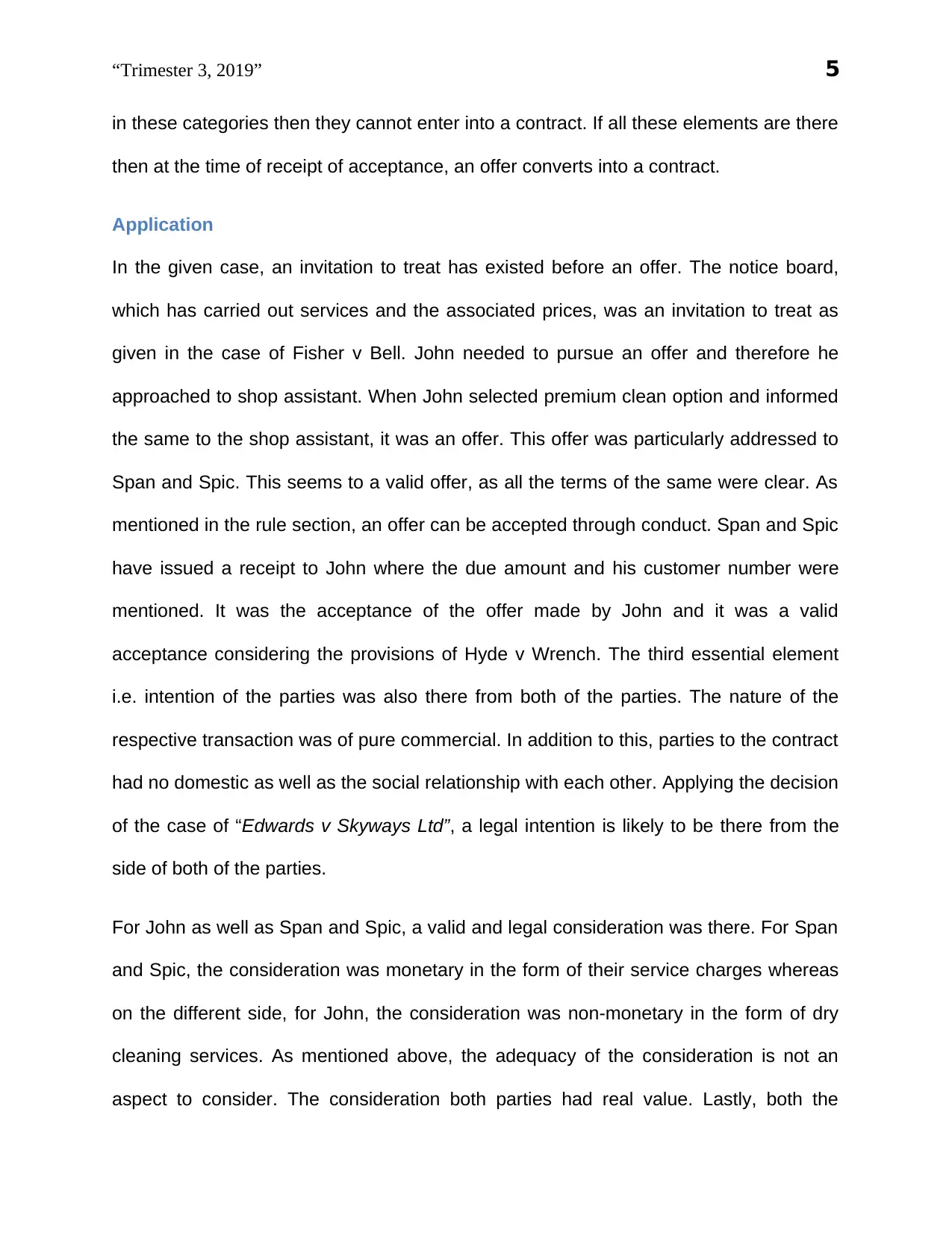
“Trimester 3, 2019” 5
in these categories then they cannot enter into a contract. If all these elements are there
then at the time of receipt of acceptance, an offer converts into a contract.
Application
In the given case, an invitation to treat has existed before an offer. The notice board,
which has carried out services and the associated prices, was an invitation to treat as
given in the case of Fisher v Bell. John needed to pursue an offer and therefore he
approached to shop assistant. When John selected premium clean option and informed
the same to the shop assistant, it was an offer. This offer was particularly addressed to
Span and Spic. This seems to a valid offer, as all the terms of the same were clear. As
mentioned in the rule section, an offer can be accepted through conduct. Span and Spic
have issued a receipt to John where the due amount and his customer number were
mentioned. It was the acceptance of the offer made by John and it was a valid
acceptance considering the provisions of Hyde v Wrench. The third essential element
i.e. intention of the parties was also there from both of the parties. The nature of the
respective transaction was of pure commercial. In addition to this, parties to the contract
had no domestic as well as the social relationship with each other. Applying the decision
of the case of “Edwards v Skyways Ltd”, a legal intention is likely to be there from the
side of both of the parties.
For John as well as Span and Spic, a valid and legal consideration was there. For Span
and Spic, the consideration was monetary in the form of their service charges whereas
on the different side, for John, the consideration was non-monetary in the form of dry
cleaning services. As mentioned above, the adequacy of the consideration is not an
aspect to consider. The consideration both parties had real value. Lastly, both the
in these categories then they cannot enter into a contract. If all these elements are there
then at the time of receipt of acceptance, an offer converts into a contract.
Application
In the given case, an invitation to treat has existed before an offer. The notice board,
which has carried out services and the associated prices, was an invitation to treat as
given in the case of Fisher v Bell. John needed to pursue an offer and therefore he
approached to shop assistant. When John selected premium clean option and informed
the same to the shop assistant, it was an offer. This offer was particularly addressed to
Span and Spic. This seems to a valid offer, as all the terms of the same were clear. As
mentioned in the rule section, an offer can be accepted through conduct. Span and Spic
have issued a receipt to John where the due amount and his customer number were
mentioned. It was the acceptance of the offer made by John and it was a valid
acceptance considering the provisions of Hyde v Wrench. The third essential element
i.e. intention of the parties was also there from both of the parties. The nature of the
respective transaction was of pure commercial. In addition to this, parties to the contract
had no domestic as well as the social relationship with each other. Applying the decision
of the case of “Edwards v Skyways Ltd”, a legal intention is likely to be there from the
side of both of the parties.
For John as well as Span and Spic, a valid and legal consideration was there. For Span
and Spic, the consideration was monetary in the form of their service charges whereas
on the different side, for John, the consideration was non-monetary in the form of dry
cleaning services. As mentioned above, the adequacy of the consideration is not an
aspect to consider. The consideration both parties had real value. Lastly, both the
⊘ This is a preview!⊘
Do you want full access?
Subscribe today to unlock all pages.

Trusted by 1+ million students worldwide
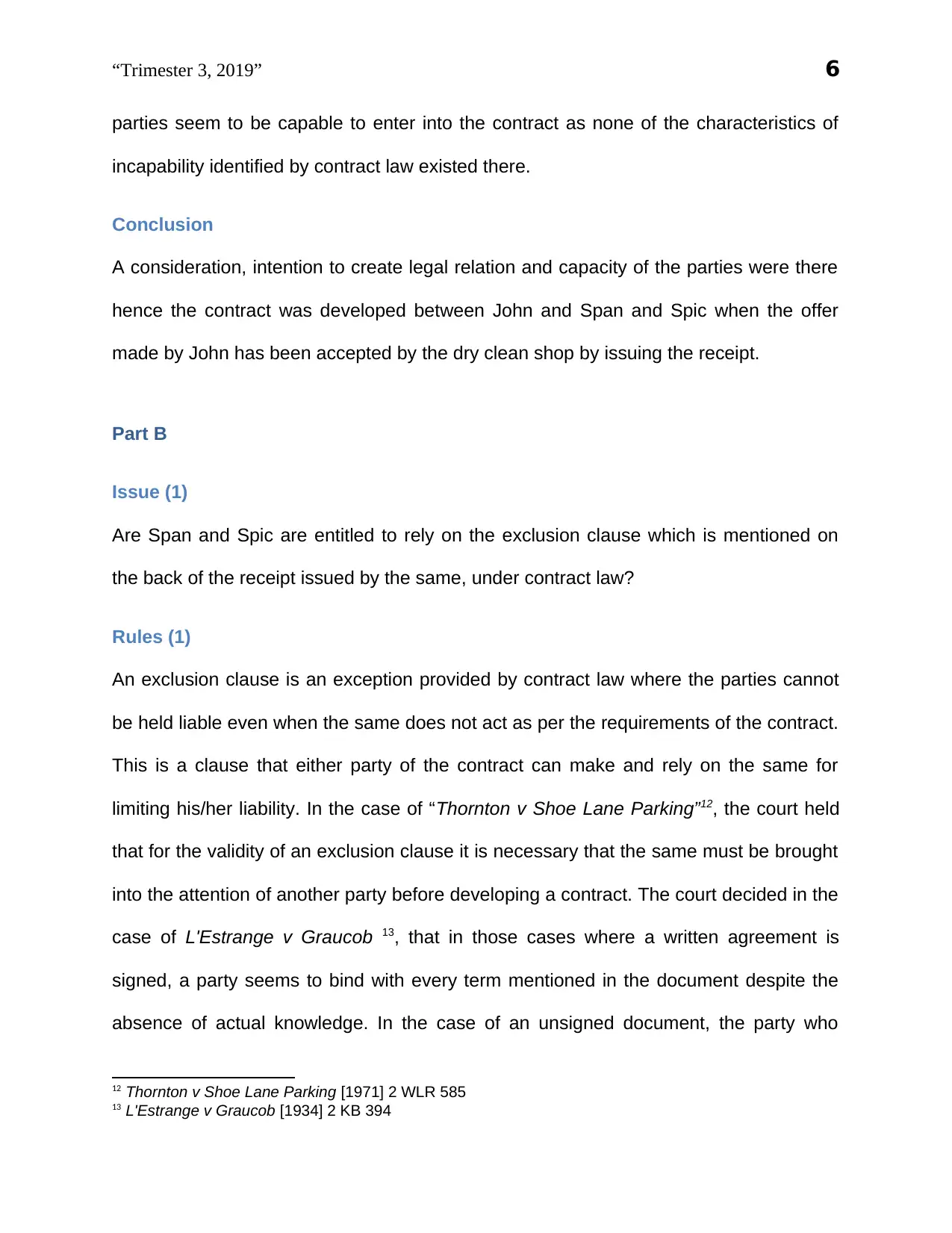
“Trimester 3, 2019” 6
parties seem to be capable to enter into the contract as none of the characteristics of
incapability identified by contract law existed there.
Conclusion
A consideration, intention to create legal relation and capacity of the parties were there
hence the contract was developed between John and Span and Spic when the offer
made by John has been accepted by the dry clean shop by issuing the receipt.
Part B
Issue (1)
Are Span and Spic are entitled to rely on the exclusion clause which is mentioned on
the back of the receipt issued by the same, under contract law?
Rules (1)
An exclusion clause is an exception provided by contract law where the parties cannot
be held liable even when the same does not act as per the requirements of the contract.
This is a clause that either party of the contract can make and rely on the same for
limiting his/her liability. In the case of “Thornton v Shoe Lane Parking”12, the court held
that for the validity of an exclusion clause it is necessary that the same must be brought
into the attention of another party before developing a contract. The court decided in the
case of L'Estrange v Graucob 13, that in those cases where a written agreement is
signed, a party seems to bind with every term mentioned in the document despite the
absence of actual knowledge. In the case of an unsigned document, the party who
12 Thornton v Shoe Lane Parking [1971] 2 WLR 585
13 L'Estrange v Graucob [1934] 2 KB 394
parties seem to be capable to enter into the contract as none of the characteristics of
incapability identified by contract law existed there.
Conclusion
A consideration, intention to create legal relation and capacity of the parties were there
hence the contract was developed between John and Span and Spic when the offer
made by John has been accepted by the dry clean shop by issuing the receipt.
Part B
Issue (1)
Are Span and Spic are entitled to rely on the exclusion clause which is mentioned on
the back of the receipt issued by the same, under contract law?
Rules (1)
An exclusion clause is an exception provided by contract law where the parties cannot
be held liable even when the same does not act as per the requirements of the contract.
This is a clause that either party of the contract can make and rely on the same for
limiting his/her liability. In the case of “Thornton v Shoe Lane Parking”12, the court held
that for the validity of an exclusion clause it is necessary that the same must be brought
into the attention of another party before developing a contract. The court decided in the
case of L'Estrange v Graucob 13, that in those cases where a written agreement is
signed, a party seems to bind with every term mentioned in the document despite the
absence of actual knowledge. In the case of an unsigned document, the party who
12 Thornton v Shoe Lane Parking [1971] 2 WLR 585
13 L'Estrange v Graucob [1934] 2 KB 394
Paraphrase This Document
Need a fresh take? Get an instant paraphrase of this document with our AI Paraphraser
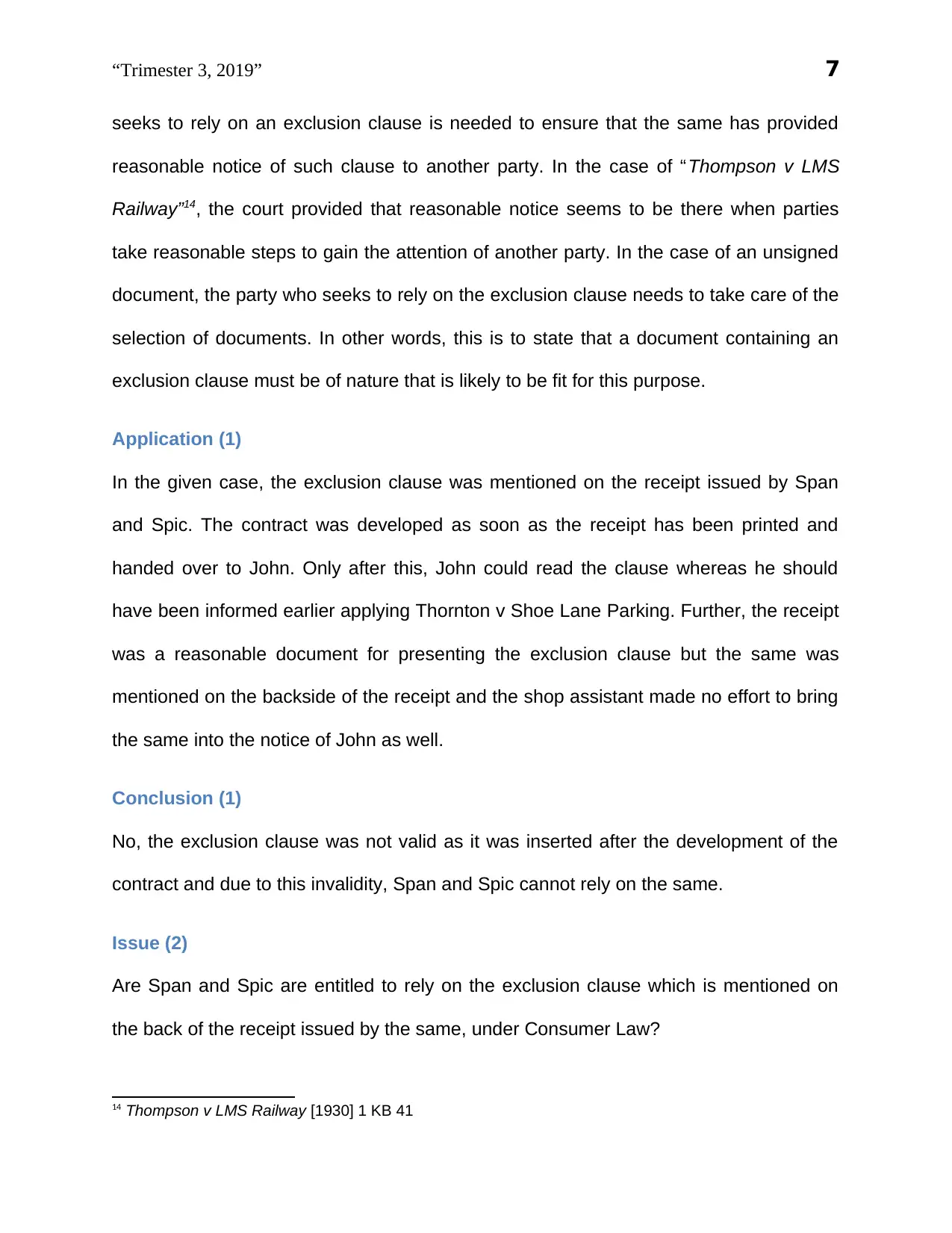
“Trimester 3, 2019” 7
seeks to rely on an exclusion clause is needed to ensure that the same has provided
reasonable notice of such clause to another party. In the case of “Thompson v LMS
Railway”14, the court provided that reasonable notice seems to be there when parties
take reasonable steps to gain the attention of another party. In the case of an unsigned
document, the party who seeks to rely on the exclusion clause needs to take care of the
selection of documents. In other words, this is to state that a document containing an
exclusion clause must be of nature that is likely to be fit for this purpose.
Application (1)
In the given case, the exclusion clause was mentioned on the receipt issued by Span
and Spic. The contract was developed as soon as the receipt has been printed and
handed over to John. Only after this, John could read the clause whereas he should
have been informed earlier applying Thornton v Shoe Lane Parking. Further, the receipt
was a reasonable document for presenting the exclusion clause but the same was
mentioned on the backside of the receipt and the shop assistant made no effort to bring
the same into the notice of John as well.
Conclusion (1)
No, the exclusion clause was not valid as it was inserted after the development of the
contract and due to this invalidity, Span and Spic cannot rely on the same.
Issue (2)
Are Span and Spic are entitled to rely on the exclusion clause which is mentioned on
the back of the receipt issued by the same, under Consumer Law?
14 Thompson v LMS Railway [1930] 1 KB 41
seeks to rely on an exclusion clause is needed to ensure that the same has provided
reasonable notice of such clause to another party. In the case of “Thompson v LMS
Railway”14, the court provided that reasonable notice seems to be there when parties
take reasonable steps to gain the attention of another party. In the case of an unsigned
document, the party who seeks to rely on the exclusion clause needs to take care of the
selection of documents. In other words, this is to state that a document containing an
exclusion clause must be of nature that is likely to be fit for this purpose.
Application (1)
In the given case, the exclusion clause was mentioned on the receipt issued by Span
and Spic. The contract was developed as soon as the receipt has been printed and
handed over to John. Only after this, John could read the clause whereas he should
have been informed earlier applying Thornton v Shoe Lane Parking. Further, the receipt
was a reasonable document for presenting the exclusion clause but the same was
mentioned on the backside of the receipt and the shop assistant made no effort to bring
the same into the notice of John as well.
Conclusion (1)
No, the exclusion clause was not valid as it was inserted after the development of the
contract and due to this invalidity, Span and Spic cannot rely on the same.
Issue (2)
Are Span and Spic are entitled to rely on the exclusion clause which is mentioned on
the back of the receipt issued by the same, under Consumer Law?
14 Thompson v LMS Railway [1930] 1 KB 41
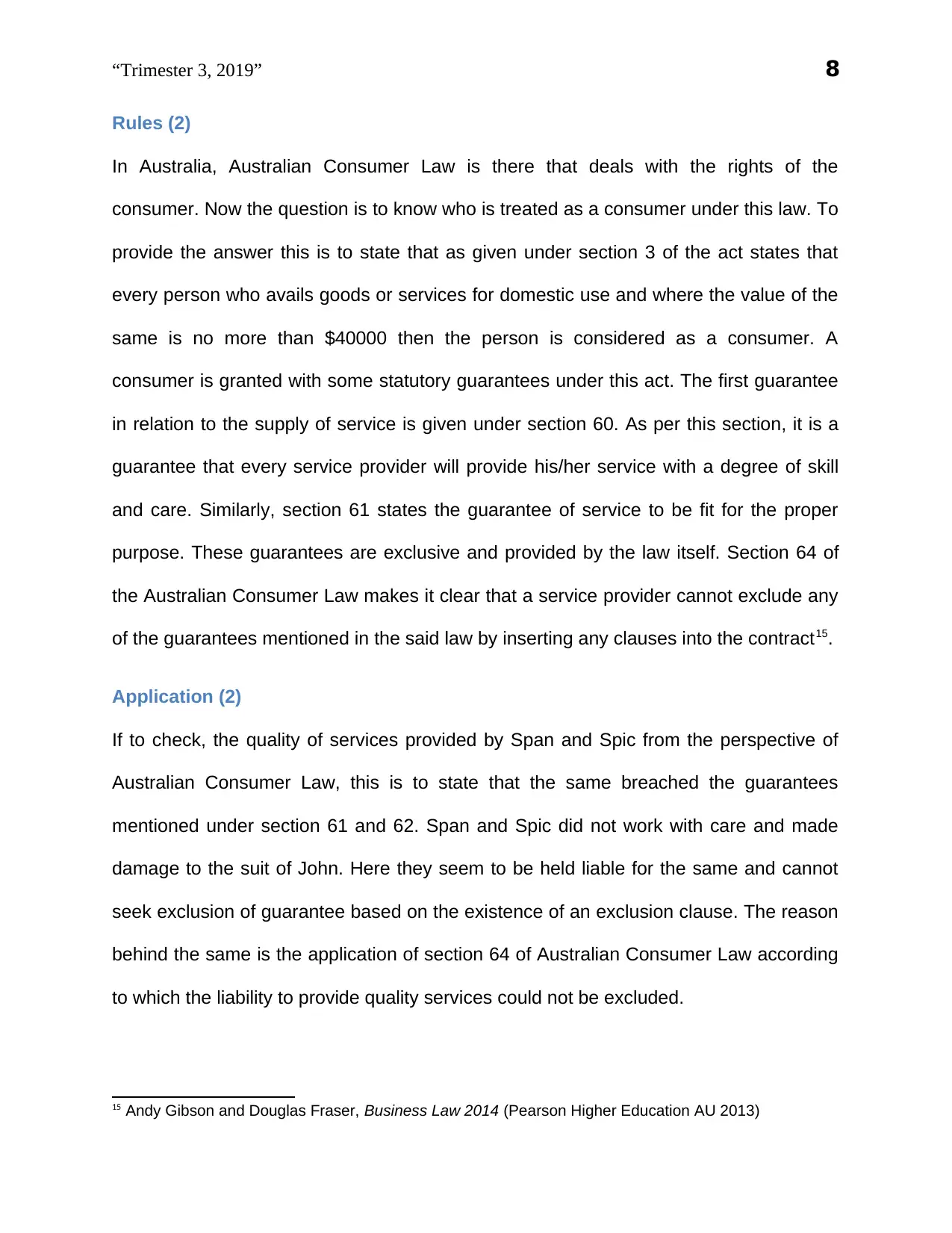
“Trimester 3, 2019” 8
Rules (2)
In Australia, Australian Consumer Law is there that deals with the rights of the
consumer. Now the question is to know who is treated as a consumer under this law. To
provide the answer this is to state that as given under section 3 of the act states that
every person who avails goods or services for domestic use and where the value of the
same is no more than $40000 then the person is considered as a consumer. A
consumer is granted with some statutory guarantees under this act. The first guarantee
in relation to the supply of service is given under section 60. As per this section, it is a
guarantee that every service provider will provide his/her service with a degree of skill
and care. Similarly, section 61 states the guarantee of service to be fit for the proper
purpose. These guarantees are exclusive and provided by the law itself. Section 64 of
the Australian Consumer Law makes it clear that a service provider cannot exclude any
of the guarantees mentioned in the said law by inserting any clauses into the contract15.
Application (2)
If to check, the quality of services provided by Span and Spic from the perspective of
Australian Consumer Law, this is to state that the same breached the guarantees
mentioned under section 61 and 62. Span and Spic did not work with care and made
damage to the suit of John. Here they seem to be held liable for the same and cannot
seek exclusion of guarantee based on the existence of an exclusion clause. The reason
behind the same is the application of section 64 of Australian Consumer Law according
to which the liability to provide quality services could not be excluded.
15 Andy Gibson and Douglas Fraser, Business Law 2014 (Pearson Higher Education AU 2013)
Rules (2)
In Australia, Australian Consumer Law is there that deals with the rights of the
consumer. Now the question is to know who is treated as a consumer under this law. To
provide the answer this is to state that as given under section 3 of the act states that
every person who avails goods or services for domestic use and where the value of the
same is no more than $40000 then the person is considered as a consumer. A
consumer is granted with some statutory guarantees under this act. The first guarantee
in relation to the supply of service is given under section 60. As per this section, it is a
guarantee that every service provider will provide his/her service with a degree of skill
and care. Similarly, section 61 states the guarantee of service to be fit for the proper
purpose. These guarantees are exclusive and provided by the law itself. Section 64 of
the Australian Consumer Law makes it clear that a service provider cannot exclude any
of the guarantees mentioned in the said law by inserting any clauses into the contract15.
Application (2)
If to check, the quality of services provided by Span and Spic from the perspective of
Australian Consumer Law, this is to state that the same breached the guarantees
mentioned under section 61 and 62. Span and Spic did not work with care and made
damage to the suit of John. Here they seem to be held liable for the same and cannot
seek exclusion of guarantee based on the existence of an exclusion clause. The reason
behind the same is the application of section 64 of Australian Consumer Law according
to which the liability to provide quality services could not be excluded.
15 Andy Gibson and Douglas Fraser, Business Law 2014 (Pearson Higher Education AU 2013)
⊘ This is a preview!⊘
Do you want full access?
Subscribe today to unlock all pages.

Trusted by 1+ million students worldwide

“Trimester 3, 2019” 9
Conclusion (2)
No, the exclusion clause was not valid as it was inserted limiting the statutory
guarantees mentioned under ACL and due to this invalidity, Span and Spic cannot rely
on the same.
Conclusion (2)
No, the exclusion clause was not valid as it was inserted limiting the statutory
guarantees mentioned under ACL and due to this invalidity, Span and Spic cannot rely
on the same.
Paraphrase This Document
Need a fresh take? Get an instant paraphrase of this document with our AI Paraphraser
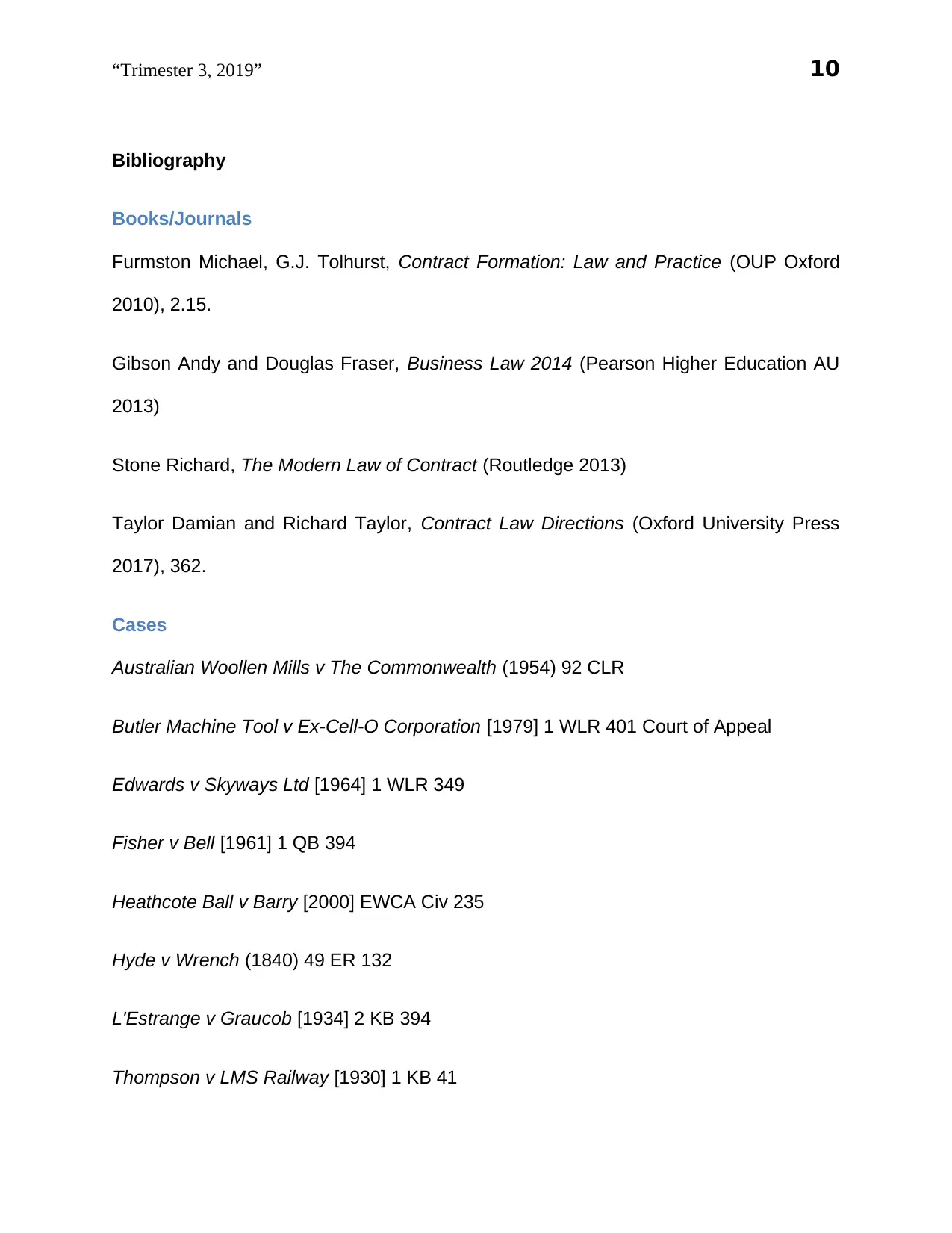
“Trimester 3, 2019” 10
Bibliography
Books/Journals
Furmston Michael, G.J. Tolhurst, Contract Formation: Law and Practice (OUP Oxford
2010), 2.15.
Gibson Andy and Douglas Fraser, Business Law 2014 (Pearson Higher Education AU
2013)
Stone Richard, The Modern Law of Contract (Routledge 2013)
Taylor Damian and Richard Taylor, Contract Law Directions (Oxford University Press
2017), 362.
Cases
Australian Woollen Mills v The Commonwealth (1954) 92 CLR
Butler Machine Tool v Ex-Cell-O Corporation [1979] 1 WLR 401 Court of Appeal
Edwards v Skyways Ltd [1964] 1 WLR 349
Fisher v Bell [1961] 1 QB 394
Heathcote Ball v Barry [2000] EWCA Civ 235
Hyde v Wrench (1840) 49 ER 132
L'Estrange v Graucob [1934] 2 KB 394
Thompson v LMS Railway [1930] 1 KB 41
Bibliography
Books/Journals
Furmston Michael, G.J. Tolhurst, Contract Formation: Law and Practice (OUP Oxford
2010), 2.15.
Gibson Andy and Douglas Fraser, Business Law 2014 (Pearson Higher Education AU
2013)
Stone Richard, The Modern Law of Contract (Routledge 2013)
Taylor Damian and Richard Taylor, Contract Law Directions (Oxford University Press
2017), 362.
Cases
Australian Woollen Mills v The Commonwealth (1954) 92 CLR
Butler Machine Tool v Ex-Cell-O Corporation [1979] 1 WLR 401 Court of Appeal
Edwards v Skyways Ltd [1964] 1 WLR 349
Fisher v Bell [1961] 1 QB 394
Heathcote Ball v Barry [2000] EWCA Civ 235
Hyde v Wrench (1840) 49 ER 132
L'Estrange v Graucob [1934] 2 KB 394
Thompson v LMS Railway [1930] 1 KB 41
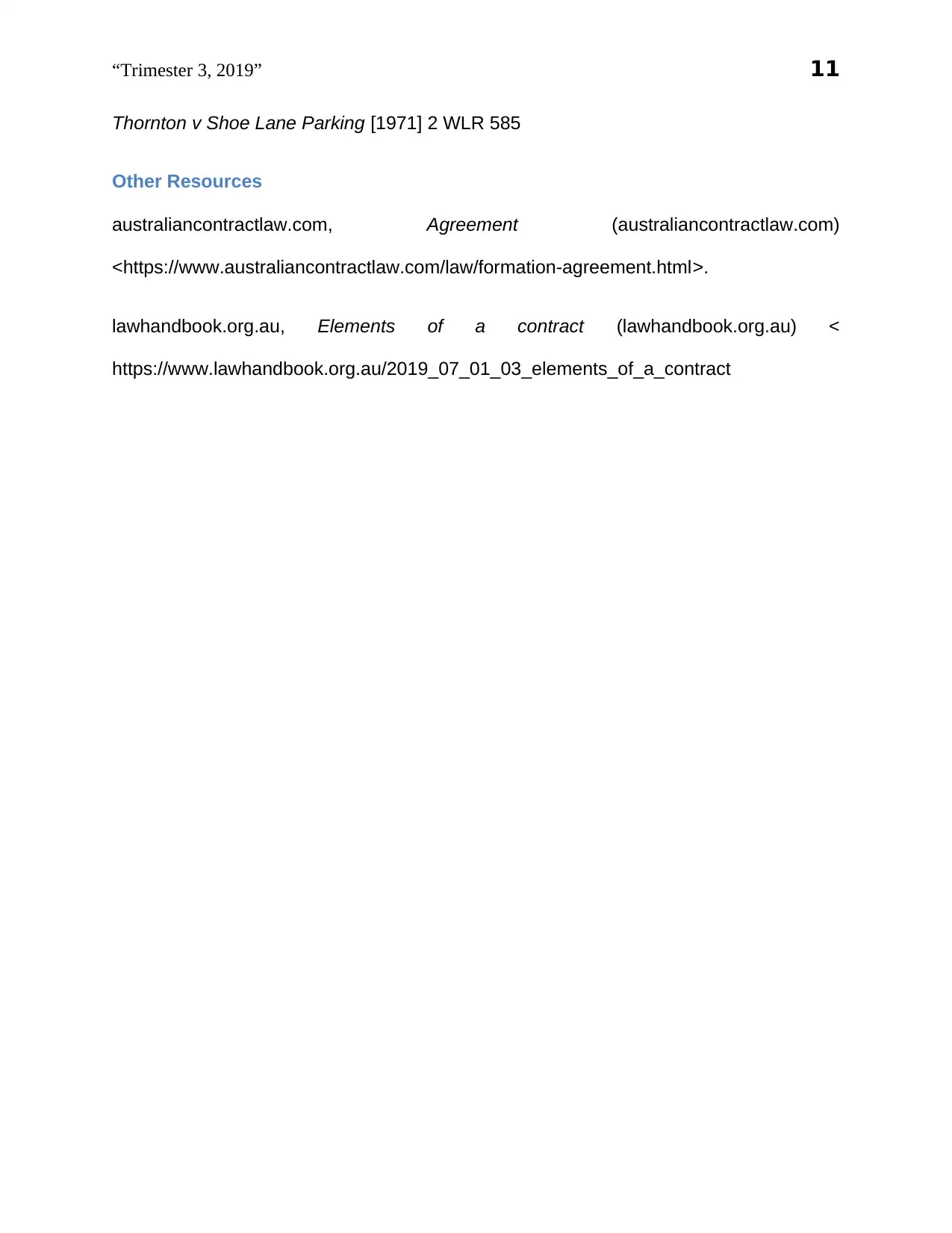
“Trimester 3, 2019” 11
Thornton v Shoe Lane Parking [1971] 2 WLR 585
Other Resources
australiancontractlaw.com, Agreement (australiancontractlaw.com)
<https://www.australiancontractlaw.com/law/formation-agreement.html>.
lawhandbook.org.au, Elements of a contract (lawhandbook.org.au) <
https://www.lawhandbook.org.au/2019_07_01_03_elements_of_a_contract
Thornton v Shoe Lane Parking [1971] 2 WLR 585
Other Resources
australiancontractlaw.com, Agreement (australiancontractlaw.com)
<https://www.australiancontractlaw.com/law/formation-agreement.html>.
lawhandbook.org.au, Elements of a contract (lawhandbook.org.au) <
https://www.lawhandbook.org.au/2019_07_01_03_elements_of_a_contract
⊘ This is a preview!⊘
Do you want full access?
Subscribe today to unlock all pages.

Trusted by 1+ million students worldwide
1 out of 12
Related Documents
Your All-in-One AI-Powered Toolkit for Academic Success.
+13062052269
info@desklib.com
Available 24*7 on WhatsApp / Email
![[object Object]](/_next/static/media/star-bottom.7253800d.svg)
Unlock your academic potential
Copyright © 2020–2025 A2Z Services. All Rights Reserved. Developed and managed by ZUCOL.





